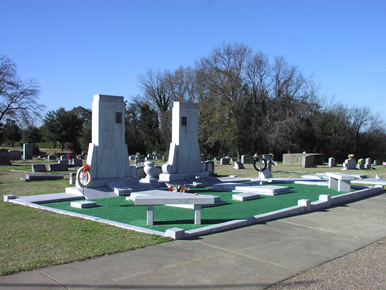The renowned Hank Williams Grave, where ceremonies are held each and every year to celebrate his life, despite its sordid end. The elaborate and gaudy cemetery plot is flood-lighted at night to retard vandalism. It’s sad to me, that with as many historical and deserving people as are interred in Oakwood Cemetery, Hank’s grave is deemed the most noteworthy. In doing research on the grave site, I came across an article that elaborates better than I could:
He had such an impact on both country and rock music that it is difficult to believe that Hank Williams lived only to the age of 29.
He was famed in his lifetime for such country hits as “Move it on Over,” “Lovesick Blues,”, “Your Cheatin’ Heart,” “Hey Good Lookin’,” and “I’m So Lonesome I Could Cry.” His influence on country & western is undeniable and in fact he may have been the most influential country artist of all time. His style also had great influence on the development of rock music.
He died far too young on New Year’s Day in 1953 and is buried today at the Oakwood Cemetery Annex in Montgomery, Alabama.
The son of a railroad worker named Elonzo “Lonnie” Williams, Hiram King Williams was born on September 23, 1923 in Mount Olive, Alabama. Lonnie’s job required the family to move several times (he was a conductor on lumber company trains), but in 1930 when Hank was only seven years old, the elder Williams suffered severe health problems.
Diagnosed with a brain aneurysm, Lonnie Williams spent the next eight years in the Veterans Hospital in Alexandria, Louisiana. The family was left to fend for itself and in 1931 moved to Georgiana, Alabama. Despite the difficult times of the Great Depression, Hank’s mother (Jessie “Lillie” Williams) was able to find decent work and the family fared better than many.
It was in 1931, when Hank Williams was 8 years old, his mother gave him his first guitar. She could not have imagined the long road it would lead him down.
Hank lived a year with his uncle and aunt, but in was reunited with his mother and siblings in Greenville, Alabama. Things went well for them there until 1937, when the 14 year old Williams was involved in a fight with a physical education coach. Lillie demanded that the coach be fired, but when the school board refused to do so, she moved her family to Montgomery.
While his mother ran a boarding house, Hank formed a band called the Drifting Cowboys. In 1941, as the clouds of World War II loomed on the horizon, Hank Williams became a regular entertainer on WSFA radio in Montgomery.
Radio stations then often featured live entertainment and WSFA provided the 18 year old singer with the opportunity to reach a large audience across Alabama.
In 1943 he met Audrey Mae Sheppard and the two were married in following year. The couple went to Nashville in 1946 and met with Fred Rose of Acuff-Rose Publishing. He liked Williams’ songs and offered him a deal to record two singles – Honky Tonkin’ and Never Again. Both records were hits and in 1947 Hank Williams signed a contract with MGM Records.
From that point, stardom came quickly. The top five hit Move it on Over was released in 1947and by 1948 Hank was part of the hugely popular Louisiana Hayride program.Mega-stardom came in 1949 when Lovesick Blues hit Number One on Billboard’s Country & Western charts and stayed there for an unbelievable 16 weeks. Not only that, but the song crossed over to the Top 25 on the pop charts. When he performed the song at the Grand Ole Opry it led to a stunning six encores for the young singer.
Hank and Audrey WIlliams had their first child in 1949, a boy they named Randall Hank. He is better known today as Hank Williams, Jr.
A remarkable string of hits followed over the next four years. Among them were Lovesick Blues; Why Don’t You Love Me; Cold, Cold Heart; Hey, Good Lookin’; Crazy Heart; Honky Tonk Blues; Jambalaya, and I’ll Never Get Out of This World Alive.
Ironically, following the release of I’ll Never Get Out of This World Alive, Hank Williams died in the back of his Cadillac on January 1, 1953. He was only 29 years old.
The official cause of death was a heart related disorder. Despite his young age, Hank Williams had lived much of his life in pain due to scoliosis. Following a surgery in 1951, he was given morphine for pain and told that he would be crippled within one year. He also drank heavily during long and lonely stretches on the road.
Ironically, three of his biggest hits were released following his death: Take These Chains From My Heart, Kaw-Liga and Your Cheatin’ Heart.
Hank Williams is buried in the Oakwood Cemetery Annex in Montgomery, Alabama. The cemetery is open to the public during normal daily hours and is free to visit. The address is 1305 Upper Wetumpka Road; Montgomery, Alabama 36107. A marble sign that reads “Hank Williams Memorial” points the way to the grave.-Dale Cox
-Charles Humphries

